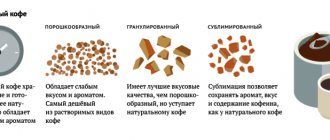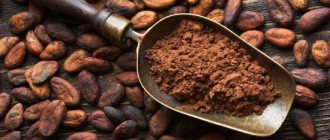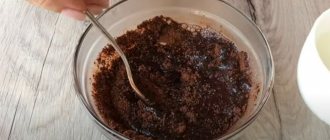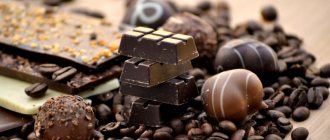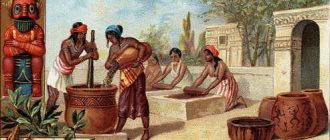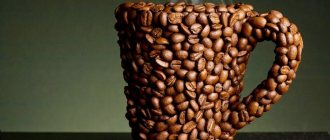What is chocolate made from?
Once the beans arrive at the factories' warehouse, they are ready to be processed. Production processes vary due to different types of trees, but most factories use similar machines to separate the beans into oil and dry powder. Chocolate is made from mass with the addition of sugar, cocoa butter and, depending on the recipe, milk. The resulting mixture is rolled out and “conched”. Conching is a procedure in which the product is constantly moved to allow the mass to thicken and turn into a homogeneous substance.
Complete benefit
If you do not abuse cocoa, then this product can rightfully be classified as only useful. True, researchers have still not come to a common conclusion about the effects of cocoa on the human body. Practice has proven that “brown gold” is excellent for treating throat diseases, pathologies of the upper respiratory tract and larynx. The antioxidant content of cocoa exceeds even that of foods such as green tea and red wine. In addition, the bioactive substances that make up the product prevent platelet aggregation. And the content of elicatechin in the product allows it to be positioned as an excellent preventative against cancer, stroke, diabetes and heart attack. For liver and kidney diseases, regular consumption of cocoa drinks is beneficial as it has an antioxidant effect. But for patients diagnosed with cirrhosis, it is better to avoid drinking cocoa. Return to content
Does chocolate have caffeine?
Cocoa-based products contain less caffeine than coffee. A chocolate bar is beneficial for mental activity due to the supply of glucose to the brain. No one wonders if there is caffeine in this bar. After all, the basis for your favorite delicacy is cocoa powder, therefore, the flow of energy is ensured not only due to the sweetness of the product.
Bitter dark chocolate contains more dry cocoa powder than milk chocolate, which raises the question of how much caffeine is contained in the bar:
- the sweet bar typically contains about 10 mg of stimulant per ounce;
- dairy treat - less than 5 mg per ounce;
- in a dark chocolate bar - in an amount from 15 to 40 mg.
For comparison, a standard cup of Americano coffee contains 50-68 mg of the stimulant.
Does white chocolate contain caffeine? No, because cocoa bean butter and milk powder are used for production; seed powder is not added there.
Caffeine content in drinks
It would take a long time to list which products contain caffeine, since this substance is found in many plants. There is a lot of it in coffee beans, tea leaves and cocoa beans used to make drinks. This natural substance is classified as a mild stimulant. Energy drinks and various types of cola are produced with the addition of a synthesized alkaloid, which gives the drinks a specific taste.
Caffeine is considered a natural antidepressant, as moderate amounts help cope with stress and depression. Significant doses of the substance can lead to an overly excited state, which can lead to serious health problems. However, a similar effect can be achieved when the body receives at least 300 mg of the substance. Fortunately, the caffeine content in drinks is so low that this is quite difficult to achieve.
Caffeine is found not only in natural coffee, but also in other drinks.
All types of coffee
Different types of coffee contain different amounts of the stimulant. For example, the Robusta variety contains much more caffeine than Arabica. Even coffee beans of the same variety have different levels of the stimulant. It may vary depending on the growing conditions of the coffee trees. In addition, the molecules of the substance are partially destroyed when the beans are roasted.
The caffeine content is also affected by the method of preparing the coffee drink. Thus, in cappuccino prepared on the basis of espresso, the concentration of the alkaloid becomes lower after adding milk. Instant coffee, which is obtained by evaporating an aqueous extract, contains more alkaloid than the natural product. Of course, if you compare the caffeine in instant coffee and ground coffee from beans of the same variety.
Teas
The question of how much caffeine is in a cup of tea requires clarification. Because different types of tea contain different amounts of this alkaloid substance. Moreover, it is impossible to answer clearly which tea has more caffeine, since its amount depends on several factors:
- quality of dry brewing (the upper shoots of the tea bush contain more substance);
- degree of fermentation of the tea leaf (long processing of black tea destroys the alkaloid);
- brewing method;
- the amount of dry tea used to prepare the drink.
Contrary to popular belief, black teas are inferior in alkaloid content to their green counterparts. This fact has been proven by scientists. They were able to experimentally determine how much caffeine is in green tea. It turns out that a cup of green tea can be compared in terms of alkaloid content with the same amount of instant coffee.
Cocoa
Many people do not realize that cocoa is a caffeine-containing drink. True, there is very little stimulating substance in cocoa powder - 15 times less than coffee and about 6 times less than tea.
Everyone's favorite chocolate is made from cocoa powder. Therefore, the question of whether there is caffeine in chocolate can be answered unequivocally, of course there is. A 100-gram bar of dark chocolate contains 70-90 mg of caffeine.
Milk chocolate is less stimulant-rich. The same hundred-gram tile contains only 5 to 60 mg of the substance.
The popular coffee substitute, chicory, does not contain caffeine.
Chicory
Chicory drink is considered by many to be the best coffee substitute. Adherents of a healthy lifestyle, busy looking for a worthy replacement for harmful products, opt for a chicory drink, which tastes a little like coffee.
Many people, interested in the composition of this plant, ask whether chicory contains caffeine. Despite the fact that chicory is considered a drink that tones the body, it does not contain caffeine. Perhaps that is why it does not excite the nervous system, but helps to balance it.
Coca Cola
Manufacturers of the drink do not indicate on the label how much caffeine is in cola. Meanwhile, a hundred gram glass of the drink contains almost 10 mg of a stimulant. Such an amount even threatens health problems for an adult, but Coca-Cola is often bought for children.
Energy
Contrary to their name, energy drinks do not give you energy. Added caffeine stimulates the use of internal resources. The content of the stimulating substance can vary quite widely.
Often between 80 mg (more than a cup of espresso) and 150 mg per can. Such an amount of stimulant with frequent use of energy drinks leads to nervous overexcitation and exhaustion of the body.
The percentage of caffeine varies depending on the drink
How much caffeine is in instant cocoa and hot chocolate.
Like any product made from cocoa beans, hot chocolate drink contains caffeine. It is a natural stimulant that is often used to provide vital alertness and energy. Consumption of foods or drinks containing this substance stimulates the nervous system and brain, helping to fight fatigue.
How much stimulant is in a cup of chocolate drink depends on how it was prepared. A 450 gram mug of hot drink contains 25 mg of caffeine. For comparison, a glass of Americano coffee contains 50-70 mg of the stimulant.
Harm and contraindications
Now we know the benefits of cocoa powder. And the harm to health cannot be ignored either. There are also contraindications. Most often, cocoa causes harm in two cases:
- If consumed in excess.
- When consuming a low-quality product.
Where is there more caffeine, coffee or cocoa? Of course, in coffee. But cocoa also contains it. The drink contains 0.2% caffeine, which may adversely affect the condition of young children, pregnant women and people with contraindications to caffeine.
Due to the presence of purines, it is advisable to limit the consumption of the drink to people who have kidney problems and gout. The reason for this is the accumulation of uric acid and the deposition of salts in the joints.
In areas where cocoa trees are grown, sanitary requirements are not high enough. The consequence of this is the presence of insects and bacteria in the fruits. To disinfect trees, they are treated with poisons and chemicals in large quantities. In some cases, exotic insects may be ground up along with the raw materials during the processing process. Then there is a high probability of an allergic reaction. Cocoa beans themselves do not contain allergens, but manufacturers of low-quality instant powders use various chemical additives, which most often cause allergies.
Since the answer to the question of whether there is caffeine in cocoa is yes, it is not recommended to drink the drink for the following categories of people:
- Children under 3 years of age.
- People suffering from diabetes, diarrhea, atherosclerosis.
- People suffering from joint diseases.
- Pregnant and lactating women.
- Overweight people.
- People with high stomach acidity.
Can cocoa replace coffee?
Since chocolate drinks are caffeine-containing products, they can be a good replacement for a cup of Americano in the morning. Despite the fact that the chocolate drink contains less caffeine than espresso. Cocoa contains a lot of theobromine, a substance that acts as a mild stimulant. Theobromine may cause a slight feeling of euphoria and satisfaction, and is also a mild stimulation of the nervous system. This means that people who choose cocoa do not harm the body due to a sharp jump in activity and a subsequent sharp decline. This drink is rich in polyphenols, which have a beneficial effect on cardiovascular diseases. Coffee consumed over several years can cause irritability or chronic fatigue.
Holland and its contribution to the history of “brown cocoa gold”
If espresso appeared thanks to the Italians, then cocoa powder and butter – thanks to the Dutch inventor van Heuten. It was he who first created a technology that made it possible to extract oil and powder from seeds, which in turn became the raw material for solid, that is, bar chocolate. But contemporaries can thank the Dutchman not only for bar chocolate. Indeed, it was thanks to his developments that the processing of raw materials became cheaper and easier, and the powder that served as the basis for the drink was no longer inaccessible to “mere mortals.” That is, not only the rich, but also people with modest incomes could now enjoy tasty and healthy drinks. The demand for a tasty drink grew by leaps and bounds, which became the impetus for the development of new production centers. And if earlier the main suppliers of raw materials were Venezuela and Ecuador, then after the drink was popularized and cheaper, the fruits began to be brought from Brazil and El Salvador.
Today, the main suppliers of beans are on the African continent, and 30% of the annual world bean harvest comes from Côte d'Ivoire. “Brown gold” is also supplied by such countries as:
- Colombia and Malaysia;
- Ecuador and Brazil;
- Cameroon and Ghana;
- Indonesia and Nigeria;
- Dominican Republic.
But, despite its African location, the chocolate tree does not tolerate direct sunlight, so in addition to cocoa trees, taller coconut palms, rubber and mango trees grow on the plantations, which perform shading functions. If climatic conditions are favorable, the trees bear fruit all year round, which allows harvesting at least twice a year. Experts know that the first harvest is of higher quality and is used to make more expensive products (elite chocolate, for example). Despite the ever-growing demand for “brown gold”, as well as its far from low price on the market, the work itself of cultivating cocoa trees is difficult and also poorly paid. In addition, in most countries, children still work on cocoa plantations, which constantly causes complaints from modern consumers. Return to content
Is there caffeine in cocoa powder?
If there is caffeine in coffee, then what is in cocoa? Cocoa powder is an unsweetened drink made by grinding the seeds of the cocoa tree. These seeds are first fermented, then dried and roasted. After roasting, the shells are removed from the beans and then processed to extract the fat, which is known as cocoa butter. The remaining solids are further ground into what is eventually sold as a powder.
Not all fat is removed from the raw material, and higher quality powders actually contain more fat. The quality of the powder can be determined by comparing the oil content in its composition.
Being a product of the seed production of this tree, the powder contains caffeine. Depending on the degree of fermentation and the type of bean, the stimulant content will vary from 0.1 to 0.5%. Powders made from well-fermented seeds of African origin have a very low proportion of stimulant: 0.1% or less.
Attention! Is there caffeine in cocoa? Those who drink the drink every day are interested in this question. This question can be answered unequivocally. The powder contains a small amount of caffeine.
Hot chocolate contains small amounts of a stimulant. Caffeine is found in cocoa powder, from which sweet bars are made. But it is significantly less than in tea, coffee and most soft drinks. In contrast, drinking a hot chocolate drink will provide more health benefits than drinking coffee.
The traditional belief is that hot chocolate is a soothing winter drink. In fact, it can be a delicious and healthy afternoon snack. Thanks to the milk content, a cup of natural chocolate drink will be an excellent treat for a child. It is useful to drink it at the end of the day, and you will not have to worry about a sudden surge of energy that prevents you from falling asleep.
Useful properties of cocoa
Note that even a chocolate bar contains a portion of caffeine. And there is much more of it in sweet Coca-Cola or energy drinks. Natural cocoa is clearly healthier than sweet soda. In addition, a chocolate drink made from cocoa bean powder has many additional bonuses:
- High iron content increases hemoglobin
- a large amount of zinc promotes wound healing and rapid cell restoration
- melanin helps protect skin from sunburn
How to determine the quality of cocoa powder? Pay attention to fat content. If the fat content is 14% or higher, then you have a quality product. If there is 12% fat content or less per 100 grams, then this powder is not entirely made from cocoa beans; it contains foreign impurities.
Cocoa beans - what are they?
Cocoa beans are almond-shaped seeds found in the fruit of the chocolate tree. They are the raw material for making chocolate.
Until the 19th century, Central American Indians used cocoa beans as bargaining chips. And the Aztecs considered cocoa a sacred gift from the god of freedom. Their value was so high that 100 beans could buy 1 slave.
Today, cocoa is cultivated in many countries with hot tropical climates. But the main suppliers are Brazil, Indonesia, Cameroon, Nigeria, New Guinea.
The first European to taste cocoa was Christopher Columbus. But he didn't feel much pleasure.
Real cocoa beans smell like chocolate with hints of vanilla. They taste bitter.
When using, you must follow the norm. For an adult weighing 70 kg, the recommended dose of raw cocoa per day is 4 - 5 tablespoons. It is better to distribute it evenly and use 1 - 1.5 tbsp. l. during the day.
If cocoa beans are abused, it can cause negative consequences, such as:
- Tachycardia;
- Insomnia;
- increased nervousness or agitation;
- Frequent urination.
We must remember that cocoa is very invigorating, so you should eat it no later than 3 hours before bedtime.
Live cocoa beans can be eaten dipped in honey. Then the taste will be more delicate and without bitterness.
To remove the skin from them, you need to pour boiling water over them for 2 minutes and then cut them lengthwise with a knife. You shouldn't throw away the skin, because... it contains many useful substances. It can be ground in a coffee grinder and used as a scrub for the face and body.
You can also grind the beans and sprinkle the resulting shavings on desserts, dip fruits in it, and add to drinks.
